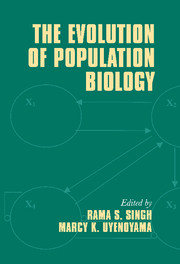Book contents
- Frontmatter
- Contents
- List of contributors
- Publications of R. C. Lewontin
- Preface
- Introduction
- Part I Historical foundations and perspectives
- Part II Genotypes to phenotypes: new genetic and bioinformatic advances
- Part III Phenotypes to fitness: genetics and ecology of populations
- Part IV Genes, organisms, and environment: evolutionary case studies
- Part V Applied population biology: biodiversity and food, disease, and health
- 17 Conservation biology: the impact of population biology and a current perspective
- 18 The emergence of modern human mortality patterns
- 19 Units of selection and the evolution of virulence
- 20 Evolutionary genetics and emergence of RNA virus diseases
- 21 A scientific adventure: a fifty years study of human evolution
- 22 Geneticists and the biology of race, 1900–1924
- Index
18 - The emergence of modern human mortality patterns
Published online by Cambridge University Press: 08 January 2010
- Frontmatter
- Contents
- List of contributors
- Publications of R. C. Lewontin
- Preface
- Introduction
- Part I Historical foundations and perspectives
- Part II Genotypes to phenotypes: new genetic and bioinformatic advances
- Part III Phenotypes to fitness: genetics and ecology of populations
- Part IV Genes, organisms, and environment: evolutionary case studies
- Part V Applied population biology: biodiversity and food, disease, and health
- 17 Conservation biology: the impact of population biology and a current perspective
- 18 The emergence of modern human mortality patterns
- 19 Units of selection and the evolution of virulence
- 20 Evolutionary genetics and emergence of RNA virus diseases
- 21 A scientific adventure: a fifty years study of human evolution
- 22 Geneticists and the biology of race, 1900–1924
- Index
Summary
Introduction
In 1977, Dick Lewontin started me thinking about human mortality patterns with an introduction to Thomas McKeown's then new analysis of mortality declines in England (McKeown 1976). McKeown proposed three features of mortality decline that have become influential: there had been long-run steady progress against mortality since the late eighteenth century; medical technology did not play a central or even important role in mortality decline through the early twentieth century; and the principal driver of mortality decline in England had been a general increase in the standard of living. We now know that McKeown was wrong about his third point but right about his first two points, which demonstrate the importance in mortality studies of analyzing long-run change and of multifactorial explanation.
In recent years human mortality has become a popular topic because of economic concern that declining mortality and fertility may result in unprecedented percentages of older people. This concern and the resulting research funding have energized the study of mortality decline and aging. These subjects can be studied at several levels, from populations to genes. My own work has concerned mortality trends and mortality forecasts, the design of public pension systems, and the development of biodemography – an attempt to integrate demographic, evolutionary, and molecular information about mortality patterns.
- Type
- Chapter
- Information
- The Evolution of Population Biology , pp. 366 - 376Publisher: Cambridge University PressPrint publication year: 2004



